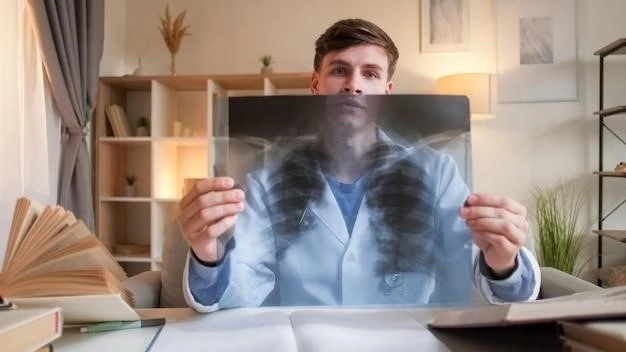Disease ‒ Idiopathic Pulmonary Fibrosis
Idiopathic Pulmonary Fibrosis is a progressive lung disease characterized by lung scarring and impaired lung function․ This article will provide an overview of the disease, its symptoms, diagnosis, treatment options, lung transplant as a treatment, pulmonary rehabilitation and therapy, and long-term management and prognosis․
Overview of Idiopathic Pulmonary Fibrosis
Idiopathic Pulmonary Fibrosis (IPF) is a type of pulmonary fibrosis, a chronic and irreversible lung disease that involves the scarring of lung tissue․ The exact cause of IPF is unknown, hence the term ″idiopathic․″ Over time, the scarring (fibrosis) of the lungs can lead to breathing difficulties, cough, and reduced lung function․ It primarily affects older adults and the prognosis is generally poor․
Individuals with IPF may experience symptoms such as persistent dry cough, shortness of breath, fatigue, unexplained weight loss, and clubbing of the fingertips․ Diagnosis often involves a combination of medical history review, imaging tests like chest X-rays or CT scans, lung function tests, and sometimes a surgical lung biopsy․
IPF is a progressive disease with a variable course, leading to worsening symptoms and decreased lung function over time․ Common complications of IPF include pulmonary hypertension, respiratory failure, and increased risk of infections․ As the disease advances, individuals may also experience chest pain, cyanosis, and require supplemental oxygen therapy to aid breathing․
Despite advancements in treatment options, IPF remains a challenging condition with limited therapeutic options․ Management typically focuses on symptom relief, slowing disease progression, and maintaining the best possible quality of life for patients․ Close monitoring, lifestyle modifications, and regular follow-ups are essential in the care of individuals with IPF․
Symptoms and Diagnosis
Idiopathic Pulmonary Fibrosis (IPF) presents with a range of symptoms related to the progressive scarring of the lungs․ The most common symptoms include persistent dry cough, shortness of breath (dyspnea), particularly during physical activity, fatigue, unexplained weight loss, and clubbing of the fingertips․
Diagnosing IPF involves a thorough evaluation starting with a detailed medical history review․ Imaging studies such as chest X-rays or high-resolution computed tomography (HRCT) scans are essential in visualizing the characteristic patterns of lung scarring․ Pulmonary function tests (PFTs) help assess lung function and capacity, while a surgical lung biopsy may be required in some cases to confirm the diagnosis․
In addition to these tests, blood work and oxygen saturation measurements play a role in the diagnostic process․ Differential diagnosis is crucial to distinguish IPF from other interstitial lung diseases that share similar symptoms․ Collaboration between pulmonologists, radiologists, and pathologists is often necessary to reach an accurate diagnosis․
Early detection of IPF is critical for initiating appropriate treatment and optimizing patient outcomes․ Healthcare providers should maintain a high index of suspicion for IPF in individuals presenting with the hallmark symptoms, especially in the elderly population․ Once a diagnosis is confirmed, a multidisciplinary approach involving specialists in respiratory medicine is vital for the comprehensive management of the disease․
Treatment Options
The management of Idiopathic Pulmonary Fibrosis (IPF) aims to alleviate symptoms, slow disease progression, and improve quality of life․ While there is no cure for IPF, several treatment modalities can help manage the condition․ Pharmacological interventions such as pirfenidone and nintedanib are approved by regulatory authorities for treating IPF by reducing lung function decline․
Supplemental oxygen therapy may be prescribed to alleviate shortness of breath and improve oxygen levels in the blood․ Pulmonary rehabilitation programs can enhance exercise tolerance, breathing techniques, and overall physical conditioning in individuals with IPF․ Vaccinations against influenza and pneumonia are crucial to prevent respiratory infections that can exacerbate the disease․
In some cases, corticosteroids and immunosuppressive medications may be used to reduce inflammation in the lungs, although their long-term efficacy in IPF management remains debatable․ Lung transplant is considered in advanced cases of IPF where lung function is severely compromised and other therapies have been ineffective․
Additionally, the importance of lifestyle modifications cannot be overstated in managing IPF․ Avoiding tobacco smoke, environmental pollutants, and other respiratory irritants is essential․ Nutritious diet, adequate hydration, and regular physical activity can contribute to overall well-being and potentially slow the progression of the disease․
Individuals with IPF should work closely with a multidisciplinary healthcare team comprising pulmonologists, respiratory therapists, physical therapists, and nutritionists to develop a comprehensive treatment plan tailored to their specific needs and stage of the disease․ Regular monitoring and adherence to therapeutic recommendations are crucial for optimizing outcomes in IPF management․
Lung Transplant as a Treatment
Lung transplant is a well-established treatment option for individuals with end-stage Idiopathic Pulmonary Fibrosis (IPF) who have severely compromised lung function and do not respond adequately to other therapies․ The procedure involves replacing one or both diseased lungs with healthy donor lungs obtained from a deceased individual or a living donor․
Prior to being considered for a lung transplant, patients undergo a comprehensive evaluation to assess their overall health status and suitability for the procedure․ Factors such as age, severity of lung disease, presence of comorbidities, and overall candidacy for surgery are carefully evaluated by a transplant team consisting of pulmonologists, surgeons, transplant coordinators, and psychologists․
Following a successful lung transplant, individuals with IPF can experience significant improvements in lung function, exercise capacity, and overall quality of life․ However, the procedure is not without risks, and patients require lifelong immunosuppressive therapy to prevent rejection of the donor lungs․
Post-transplant care is crucial for the long-term success of the procedure․ Regular follow-up visits, pulmonary rehabilitation, adherence to medications, and close monitoring for signs of rejection or infection are vital components of post-transplant management․ Despite the complexities and challenges associated with lung transplantation, it remains a valuable therapeutic option for selected individuals with advanced IPF․
Pulmonary Rehabilitation and Therapy
Pulmonary rehabilitation plays a vital role in the holistic management of individuals with Idiopathic Pulmonary Fibrosis (IPF)․ These structured programs encompass a combination of exercise training, education, and psychosocial support to improve respiratory muscle strength, enhance exercise tolerance, and promote overall well-being․
Exercise training in pulmonary rehabilitation focuses on aerobic activities, strength training, and breathing exercises to optimize lung function and physical conditioning․ Education components cover topics such as proper inhaler use, energy conservation techniques, and nutritional guidance to support optimal health in individuals with IPF․
In addition to exercise and education, pulmonary rehabilitation programs integrate psychological support and counseling to address anxiety, depression, and emotional challenges that may arise as a result of living with a chronic lung condition․ Social support and peer interaction within these programs can also positively impact mental health and coping strategies․

Furthermore, supplemental therapies such as oxygen therapy, respiratory treatments, and airway clearance techniques may be incorporated into pulmonary rehabilitation to alleviate symptoms and enhance lung function in individuals with IPF․ The multidisciplinary nature of these programs ensures that patients receive comprehensive care tailored to their specific needs and goals․
Collaboration between pulmonologists, respiratory therapists, physical therapists, and mental health professionals is key in delivering effective pulmonary rehabilitation and therapy for individuals with IPF․ By addressing the physical, emotional, and social aspects of the disease, these programs play a critical role in enhancing quality of life and functional status in patients living with IPF․
Long-Term Management and Prognosis
Long-term management of Idiopathic Pulmonary Fibrosis (IPF) focuses on symptom control, disease progression monitoring, and optimizing quality of life for individuals․ Regular follow-up assessments, including lung function tests, imaging studies, and symptom evaluations, are essential to track the course of the disease and adjust treatment strategies accordingly․
Given the progressive nature of IPF, healthcare providers emphasize the importance of lifestyle modifications in managing the condition․ This includes smoking cessation, environmental toxin avoidance, proper nutrition, staying physically active within individual limits, and maintaining a safe living environment to reduce the risk of respiratory infections․
Prognosis in IPF varies among individuals and is influenced by factors such as age, extent of lung scarring, presence of comorbidities, response to treatment, and overall health status․ While IPF is associated with a generally poor prognosis due to the irreversible nature of lung scarring, advancements in treatment options and supportive care have enhanced outcomes for some patients․
As the disease progresses, individuals with IPF may experience worsening symptoms such as increased dyspnea, persistent cough, fatigue, and decreased exercise tolerance․ Palliative care plays a crucial role in addressing symptom management, psychosocial support, and end-of-life care for patients with advanced IPF․
Communication between healthcare providers, patients, and caregivers is paramount in establishing realistic expectations, discussing treatment goals, and ensuring that care aligns with individual preferences and values․ While the management of IPF can be challenging, a multidisciplinary approach, tailored treatment plans, and ongoing support can positively impact the long-term outlook for individuals living with this chronic lung condition․
